Wai-Fah Chen.The Civil Engineering Handbook
Подождите немного. Документ загружается.

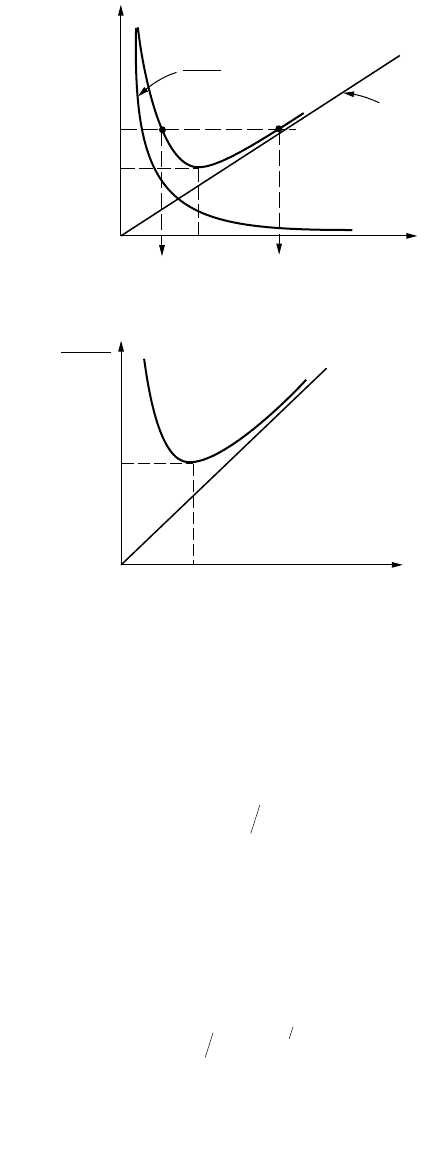
30-8 The Civil Engineering Handbook, Second Edition
If the slope is small and the velocity profile is flat, this reduces to the previous expression for the wave
celerity.
The behavior of the specific energy function can be clarified by considering the rectangular channel,
for which Eq. (30.16) becomes
(30.20)
The variation of E with d for a rectangular channel assuming constant a and q is shown in Fig. 30.4(a).
For any value of E > E
min
there are two possible flow thicknesses, d
R
< d
c
corresponding to supercritical
flow and d
T
> d
c
for subcritical flow. These are called alternate thicknesses (or alternate depths in the small
slope case). For E = E
min
only one thickness is possible. It is impossible to transmit the specified flowrate
for E < E
min
. Eq. (30.20) can also be presented in dimensionless form as shown in Fig. 30.4(b) and in
Table 30.1. In a rectangular channel, Eq. (30.18) can be solved explicitly for the critical thickness.
(30.21)
and the corresponding minimum of specific energy for a rectangular channel is
(30.22)
In reality, a always varies with d. When the variation is appreciable, as in the case of a river and its
flood plain, there may be multiple local extrema in the specific energy vs. thickness curve and hence
FIGURE 30.4 (a) Specific energy diagram for rectangular channel; (b) Dimensionless specific energy diagram for
rectangular channel.
E
E
1
E
min
=1.5d
c
cos θ
d
1
d
c
d
d/d
c
d
2
a. Specific Energy Diagram
b. The Non-Dimensional Specific Energy Diagram
αq
2
2gd
2
E
d
c
cosθ
d cos θ
1
1.5
Ed q gd=+
()
cosqa
22
2
dqg
c
=
()
[]
aq
2
13
cos
Ed
cmin
. cos= 15 q
© 2003 by CRC Press LLC

Open Channel Hydraulics 30-9
multiple critical depths. Discussion of this recently recognized phenomenon is found in Chaudhry (1993),
Sturm (2000), and Jain (2001). Channels having a single critical depth are called regular.
Hydraulic Jump
A hydraulic jump is a sudden increase in depth that occurs when the flow changes from supercritical to
subcritical as a result of a rapid deceleration. For a stationary hydraulic jump in a horizontal rectangular
channel, the depth before the jump, y
1
, and the depth after the jump, y
2
, are related by the expression
(30.23)
where Fr
1
= V
1
/(gy
1
)
1/2
is the Froude number of the flow before the jump.
The depths y
1
and y
2
are called conjugate depths (they are not alternate depths). The formula obtained
by interchanging the subscripts is also valid. The head loss in this hydraulic jump, h
J
, is given by
(30.24)
The length of the jump is approximately 6y
2
for Fr
1
> 4.5. The hydraulic jump is an effective means
of dissipating excess kinetic energy in supercritical flows.
Example 30.1 Subcritical Flow on a Step
Consider the subcritical flow in the rectangular horizontal channel shown in Fig. 30.5, which presents
an upward step of height s with respect to the direction of the current. The specific energy upstream of
TABLE 30.1 Dimensionless Specific Energy for a Rectangular Channel (Giorgini, 1987)
E/d
c
cosq
E/y
c
d
R
/d
c
y
R
/y
c
d
T
/d
c
y
T
/y
c
E/d
c
cosq
E/y
c
d
R
/d
c
y
R
/y
c
d
T
/d
c
y
T
/y
c
1.500
1.505
1.510
1.515
1.520
1.525
1.530
1.540
1.550
1.560
1.570
1.580
1.590
1.600
1.625
1.650
1.675
1.700
1.750
1.800
1.850
1.900
2.000
2.100
2.200
2.300
2.400
1.000
.944
.923
.906
.893
.881
.871
.853
.838
.825
.812
.801
.791
.782
.761
.742
.726
.711
.685
.663
.644
.627
.597
.572
.551
.532
.515
1.000
1.060
1.086
1.107
1.125
1.141
1.156
1.182
1.207
1.229
1.250
1.270
1.289
1.308
1.351
1.392
1.431
1.468
1.539
1.606
1.671
1.734
1.855
1.971
2.085
2.196
2.306
2.500
2.600
2.800
3.000
3.500
4.000
4.500
5.000
5.500
6.000
7.000
8.000
9.000
10.000
11.000
12.000
14.000
16.000
18.000
20.000
25.000
30.000
35.000
40.000
45.000
50.000
0.500
0.486
4.62
0.442
0.402
0.371
0.347
0.327
0.310
0.296
0.273
0.254
0.239
0.226
0.215
0.206
0.190
0.178
0.167
0.159
0.142
0.129
0.120
0.112
0.106
0.100
2.414
2.521
2.733
2.942
3.458
3.963
4.475
4.980
5.483
5.986
6.990
7.992
8.994
9.995
10.996
11.997
13.997
15.998
17.998
19.999
24.999
29.999
35.000
40.000
45.000
50.000
yy Fr
21 1
2
12
18 1 2=+
()
-
È
Î
Í
˘
˚
˙
hEE yy yy
J
=-= -
()()
12 21
3
12
4
© 2003 by CRC Press LLC
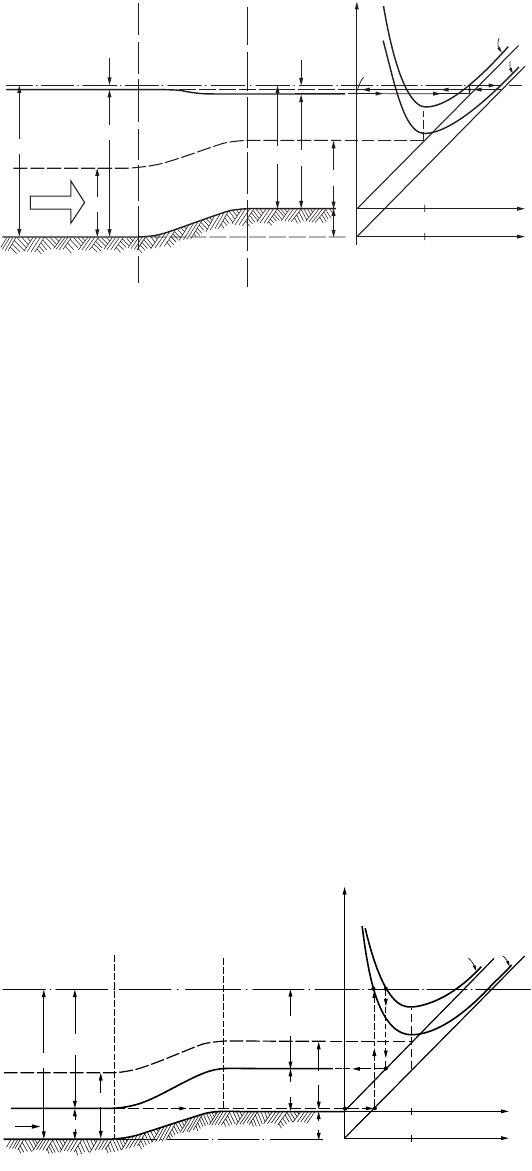
30-10 The Civil Engineering Handbook, Second Edition
the step is larger than the minimum (3y
c
/2) and the flow is subcritical. The water surface elevation at
section 1 is higher than at section 2. Given q = 10 m
2
/s, y
2
= 3.92 m, and s = 0.5 m, find y
1
, assuming
no losses.
1. Find y
c
= (q
2
/g)
1/3
= 2.17 m
2. Find E
2
= y
2
+ q
2
/(2gy
2
2
) = 4.25 m
3. Find E
1
= E
2
+ s = 4.75 m
4. Enter Table 30.1 with E
1
/y
c
= 2.19
5. Find y
1
/y
c
= 2.07. Thus y
1
= 4.49 m.
This result can also be obtained by solving Eq. (30.20). If the bottom of the upward step increases
very gradually, one can find intermediate points along the step as shown in Fig. 30.5. It is useful to draw
the critical depth line in order to visualize the relative distance of the free surface profile from it. Fig. 30.5
also illustrates a graphical technique based on the curve E(y). Follow the path A, B, C, D, E, F. The limit
case is where the specific energy on the upper part of the step is a minimum, i.e., where the depth is critical.
Example 30.2 Supercritical Flow on a Step
Consider the supercritical flow in the rectangular horizontal channel shown in Fig. 30.6, which presents
an upward step of height s with respect to the direction of the current. The specific energy upstream of
the step is larger than the minimum specific energy (3y
c
/2) and the flow is supercritical. The water depth
at cross section 2 is larger than at section 1 due to the decreased kinetic energy of the stream. Given q =
10 m
2
/s, y
1
= 1.2 m, s = 0.5 m, find y
2
, assuming no losses.
FIGURE 30.5 Subcritical stream on upward step.
FIGURE 30.6 Supercritical stream on upward step.
E
1
q
I
II
1
2
y
1
s
y
c
E
2
E
1
,E
2
y
2
y
2
y
1
y
c
B
C
F
A
E
I
II
D
y
c
y
c
q
2
/2gy
2
2
q
2
/2gy
2
1
y
1
E
1
,E
2
E
1
I
II
1
2
y
c
y
2
s
y
c
y
c
y
2
y
1
y
c
q
12
F
A
B
E
D
C
v
1
/2g
2
v
2
/2g
2
II
I
© 2003 by CRC Press LLC
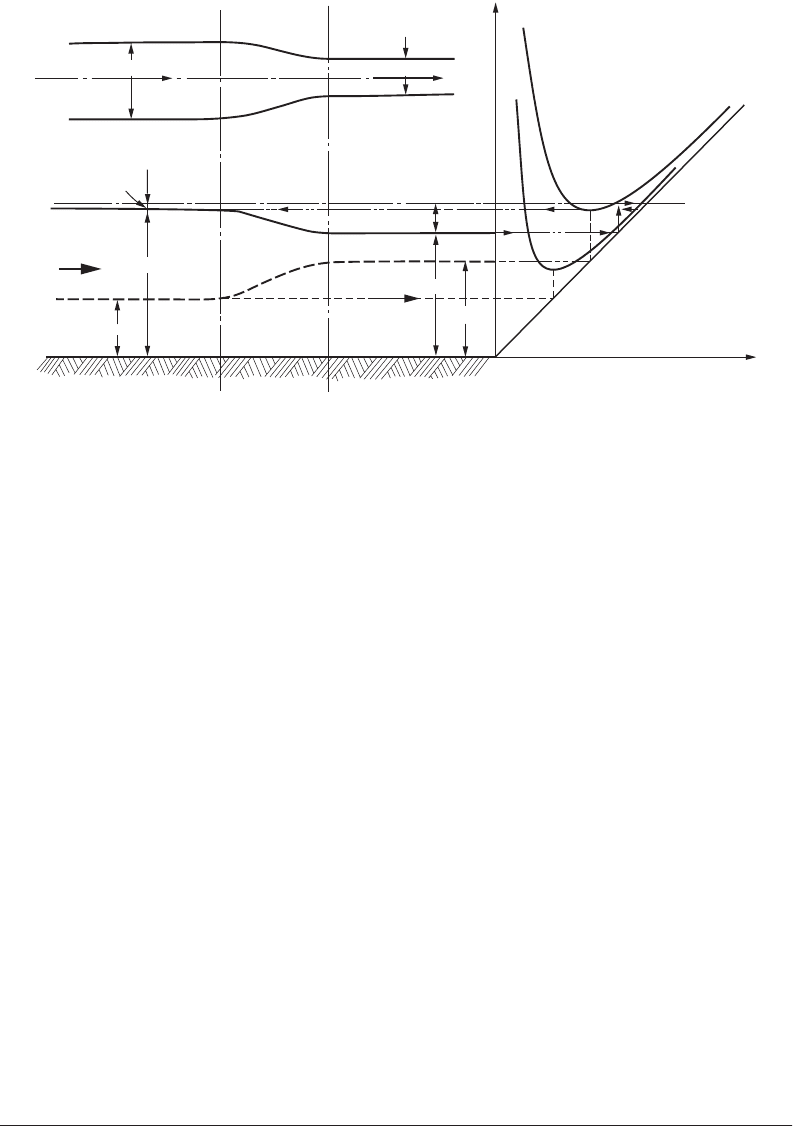
Open Channel Hydraulics 30-11
1. Find y
c
= (q
2
/g)
1/3
= 2.17 m
2. Find E
1
= y
1
+ q
2
/(2gy
1
2
) = 4.74 m
3. Find E
2
= E
1
- s = 4.24 m
4. Enter Table 30.1 with E
2
/y
c
= 1.95
5. Find y
2
/y
c
= 0.612, thus y
2
= 1.33 m.
This result can also be obtained from Eq. (30.20). Fig. 30.6 shows a graphical technique based on the
curve E(y). Follow the path A, B, C, D, E, F. The limit case occurs where the specific energy on the upper
part of the step is a minimum, i.e., where the depth is critical.
Example 30.3 Contraction in a Subcritical Stream
Consider the horizontal rectangular channel of Fig. 30.7 with a lateral contraction in the direction of the
current. The width of the contracted channel is half that of the upstream channel. The specific energy
upstream of the contraction is larger than E
min
= 3y
c
/2. The water depth at section 2 is shallower than at
section 1 as the kinetic energy of the stream increases. Given q = 10 m
2
/s, y
2
= 5.46 m, find y
1
, assuming
no losses.
1. Find y
c1
= (q
1
2
/g)
1/3
= 2.17 m and y
c2
= [(2q
1
)
2
/g]
1/3
= 3.44 m
2. Find E
1
= E
2
= y
2
+ (2q
1
)
2
/2gy
2
2
= 6.14 m
3. Enter Table 30.1 with E
1
/y
c1
= 2.83.
4. Find y
1
/y
c1
= 2.76, thus y
1
= 5.99 m.
It is seen that E
2
> 1.5y
c2
= 5.16 m, thus the flow is subcritical in the contraction. Fig. 30.7 shows a
graphical technique based on the curve E(y). Follow the path A, B, C, D, E, F. The limiting case occurs
when y
2
= y
c2
. Further information on sills, contractions, and expansions for subcritical and supercritical
flows can be found in Ippen (1950).
30.3 Uniform Flow
When a steady flowrate is maintained in a prismatic channel, a constant depth flow will be reached
somewhere in the channel if it is long enough. Such a flow is called uniform flow or normal flow. In
uniform flow there is a perfect balance between the component of fluid weight in the direction of flow
FIGURE 30.7 Subcritical stream in a channel contraction.
1
2
y
q
1
q
L
2
C
D
E
B
A
F
v
2
2
/2g
v
2
1
/ 2g
y
2
y
1
y
c
y
'
c
2q
E
q
2q
2q
L/2
© 2003 by CRC Press LLC

30-12 The Civil Engineering Handbook, Second Edition
and the resistance to flow exerted by the channel lining. Assuming that the average shear stress t given
by Eq. (30.7) is proportional to the square of the average velocity gives
(30.25)
Equation (30.25) is called the Chezy equation and C is the Chezy C, a dimensional factor which
characterizes the resistance to flow. The Chezy C may depend on the channel shape, size, and roughness
and on the Reynolds number. Equation (30.25) and the equations derived from it are often applied to
gradually varied flows. In these cases, S is interpreted as the slope of the total head line, called the friction
slope. Numerous equations have been suggested for the evaluation of C. The most popular was proposed
independently by several engineers including Manning for high Reynolds numbers where the flow is
independent of Reynolds number (fully rough flow). This is
(30.26)
where B is a dimensional constant equal to 1 m
1/3
/sec in the International System (SI) or 1.486 ft
1/3
/sec
in the U. S. Customary System, and n is a dimensionless number characterizing the roughness of a surface.
Table 30. 2 lists typical values of n; a much more comprehensive table is given by Chow (1959). Many
investigators have proposed equations relating n to a typical particle size in particle lined streams. As an
example, Subramanya (1982) proposed
(30.27)
where d
50
is the diameter in meters chosen so that 50% of the particles by weight are smaller.
Substituting Eq. (30.26) in Eq. (30.25) gives
(30.28)
Multiplying this by the flow area A yields
(30.29)
TABLE 30.2 Manning Roughness Coefficient
(Giorgini, 1987)
Nature of Surface n
min
n
max
Neat cement surface
Concrete, precast
Cement mortar surfaces
Concrete, monolithic
Cement rubble surfaces
Canals and ditches, smooth earth
Canals:
Dredged in earth, smooth
In rock cuts, smooth
Rough beds and weeds on sides
Rock cuts, jagged and irregular
Natural streams:
Smoothest
Roughest
Ve r y w eedy
0.010
0.011
0.011
0.012
0.017
0.017
0.025
0.025
0.025
0.035
0.025
0.045
0.075
0.013
0.013
0.015
0.016
0.030
0.025
0.033
0.035
0.040
0.045
0.033
0.060
0.150
VCRS=
CBRn=
16
nd= 0 047
50
16
.
V
B
n
RS=
23 12
Q
B
n
AR S KS==
23 12 12
© 2003 by CRC Press LLC
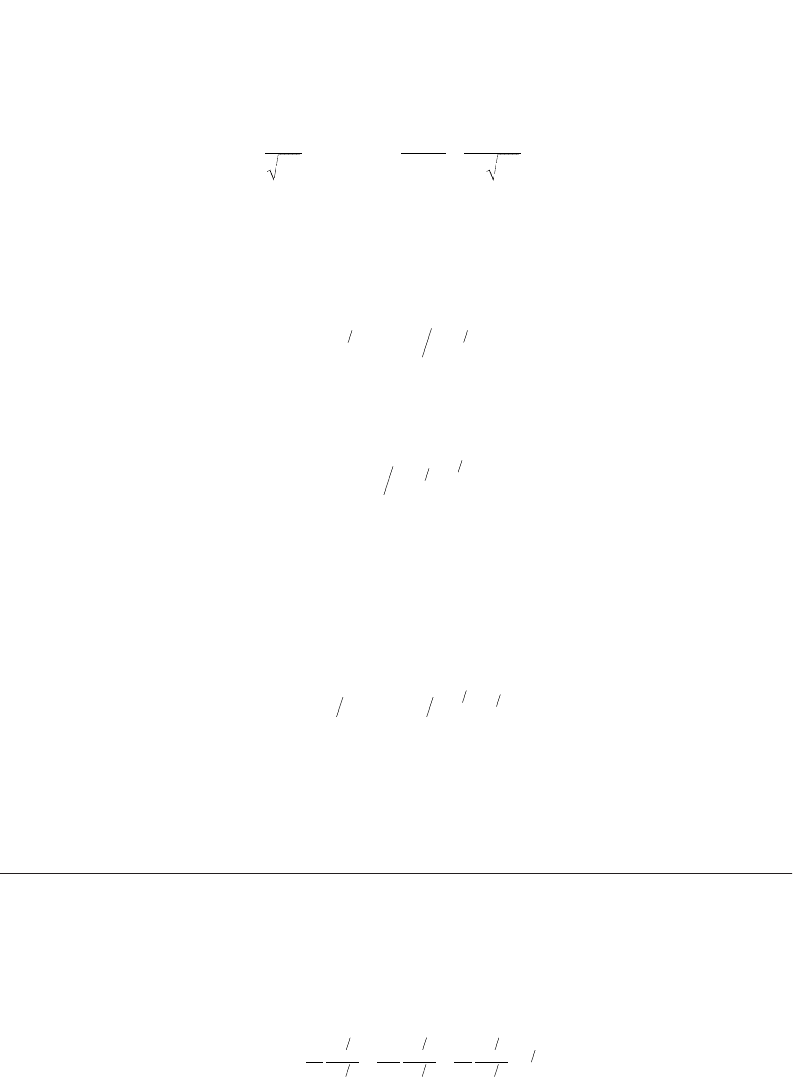
Open Channel Hydraulics 30-13
Equations (30.28) and (30.29) are both called the Manning equation. The multiplier of S
1/2
in
Eq. (30.29) is called the conveyance of the cross-section, K.
Because Eq. (30.26) is valid only for fully rough flow, the Manning equation is likewise limited.
Henderson (1966) proposed that for water at ordinary temperatures, the Manning equation is valid if
(30.30)
In the event that the Henderson criterion is violated, but the flow is nonetheless turbulent (Re > 8000),
C can be calculated iteratively from a transformation of the Colebrook equation of pipe flow.
(30.31)
Here, e is the equivalent sand grain roughness (Henderson, 1966, Table 4.1, p. 95).
The thickness of a uniform flow is called the normal thickness, d
o
. Assuming that the Manning equation
is valid, the normal thickness for a general cross section is found by solving Eq. (30.29) for d
o
. This is
facilitated by writing the Manning equation so that the factors which depend on d are on the left side.
(30.32)
The expression AR
2/3
is called the section factor for uniform flow. For most cross sections, Eq. (30.32)
must be solved numerically, but for a wide rectangular channel d
o
can be calculated directly from
(30.33)
For open top cross sections, d
o
is unique; but when the channel has a gradually closing top, such as a
circular pipe, there will be two normal depths for some flowrates. For the case of an open top section,
if d
o
> d
c
the normal flow is subcritical and the channel slope is mild; if d
o
< d
c
the normal flow is
supercritical and the channel slope is steep. The critical slope, S
c
, for which uniform flow is also critical
flow, can be found for a wide rectangular channel by equating the thicknesses given by Eqs (30.21) and
(30.33) and solving for S
c
.
(30.34)
A channel whose bottom slope is less then S
c
is called mild and a channel whose bottom slope is larger
than S
c
is called steep. For a wide rectangular channel, Eq. (30.34) can be solved for the critical discharge,
q
c
, when S, n, and a are fixed, or the critical Manning coefficient, n
c
, when S, a, and q are fixed.
30.4 Composite Cross-Sections
Consider the determination of the discharge, global Manning n, normal depth, and critical depth of a
composite section as shown in Fig. 30.8(a) having a small slope. The three parts of the global channel
are assumed to behave as three different channels in parallel with the same slope and the same water
surface elevation. The wetted perimeters of the subsections include only the portions of the solid bound-
ary belonging to that subsection. According to the Manning equation, the total discharge is
(30.35)
nRS
12 26 26
1 100 10 3 61 10≥ ¥=¥
--
..mft
C
g
R
C
g8
20
14 8
251
8
10
=- +
È
Î
Í
Í
˘
˚
˙
˙
. log
.
.
e
Re
AR nQ BS
d
O
23 12
()
=
()
dnqBS
o
=
()
[]
12
35
SnBg q
c
=
()( )
-
2109
29
cosqa
QB
n
A
Pn
A
Pn
A
P
S
l
l
lm
m
mr
r
r
=++
Ê
Ë
Á
ˆ
¯
˜
111
53
23
53
23
53
23
12
© 2003 by CRC Press LLC
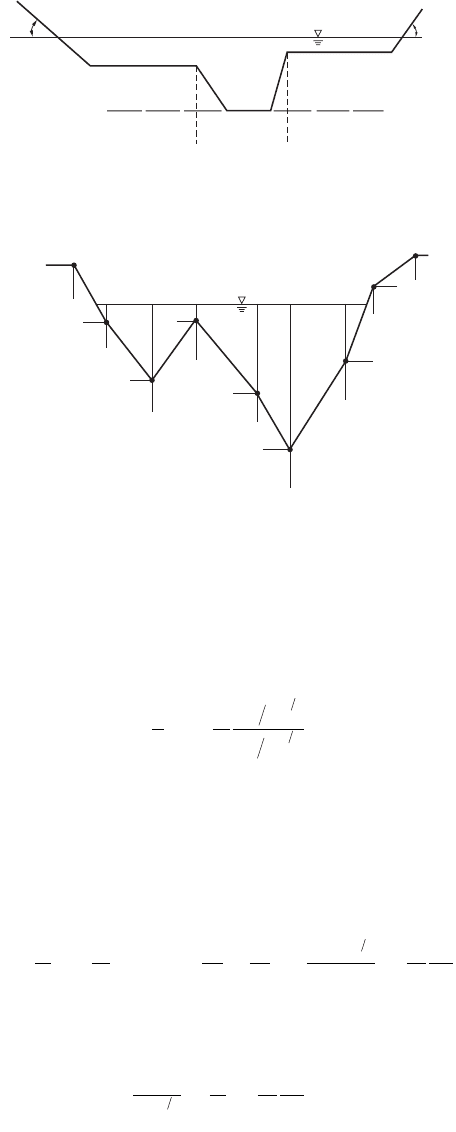
30-14 The Civil Engineering Handbook, Second Edition
where the subscripts l, m, r refer to the left overbank, the main channel, and the right overbank.
From Eq. (30.35) with A representing the total cross sectional area and P the total wetted perimeter,
the global value of n is
(30.36)
Given the quantities Q, S, n
1
, n
m
, and n
r
, and given the functions A
1
(y), A
m
(y), A
r
(y), P
1
(y), P
m
(y), and
P
r
(y), the normal depth is the root y
o
of Eq. (30.35). Then y
o
can be substituted to find the actual values
of the areas and wetted perimeters of the subsections to obtain Q
1
, Q
m
, and Q
r
.
To find the critical depth it is necessary to obtain an estimate of the kinetic energy correction factor.
For an irregular cross section, a defined in Eq. (30.13) becomes
(30.37)
Substituting Eq. (30.37) into Eq. (30.18) (for small slopes) yields
(30.38)
The critical depth is obtained by solving Eq. (30.38) for y = y
c
. Numerical techniques are generally
needed to obtain the root(s).
FIGURE 30.8 Composite cross-sections.
Left Overbank Main Channel Right Overbank
R
L
(a)
q
L
q
R
n
1
n
m
b
1
S
1
S
2
S
4
S
3
S
5
S
6
b
6
b
5
S
7
b
7
b
8
b
9
S
8
S
9
b
2
b
4
b
3
n
r
(b)
11
53
23
nn
AA
PP
i
l
r
i
i
=
()
()
Â
a=
Ê
Ë
Á
ˆ
¯
˜
=
Ê
Ë
Á
ˆ
¯
˜
Ê
Ë
Á
ˆ
¯
˜
=
ÂÂÂ
11
3
3
2
3232
33
3
2
A
V
V
A
Q
Q
A
A
BAS
Qn
A
P
i
i
i
l
r
l
r
ii
l
r
i
i
gQ
BS
T
An
A
P
i
l
r
i
i
y
c
332 3
3
2
1
=
Ê
Ë
Á
ˆ
¯
˜
Â
© 2003 by CRC Press LLC
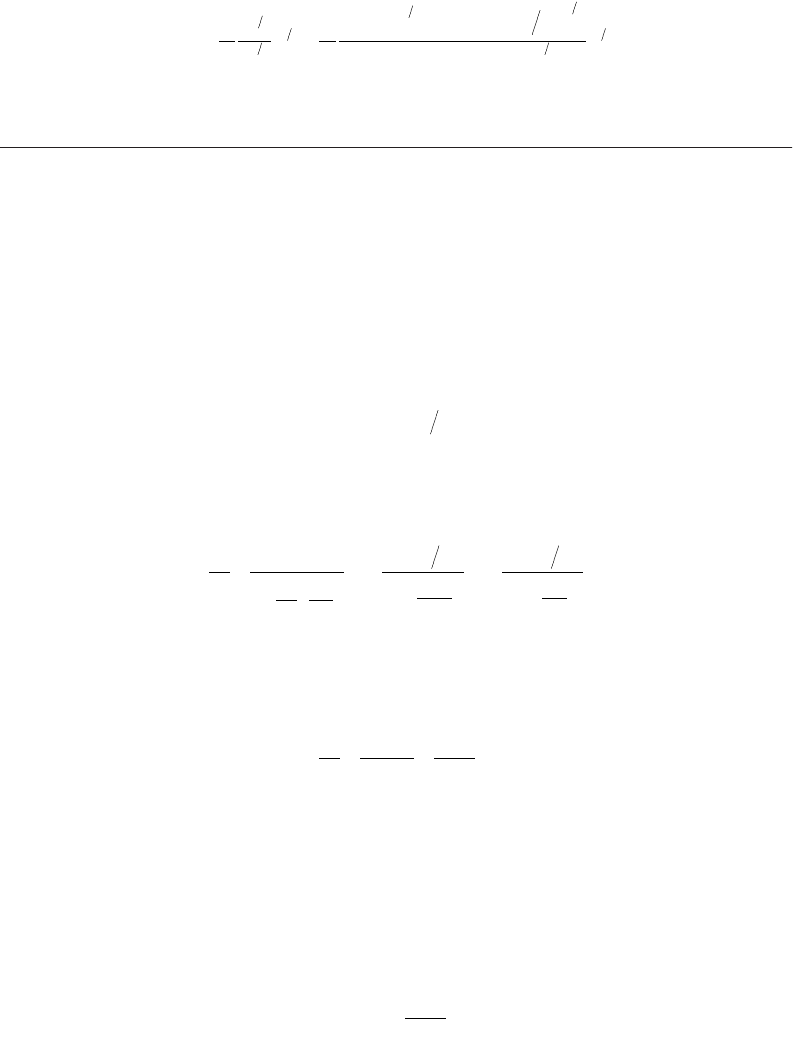
Open Channel Hydraulics 30-15
Usually river cross sections are given as sequences of station abscissas, s
i
, and bottom elevations, b
i
,
and a general cross section is approximated as shown in Fig. 30.8(b). With z
i
as the water surface elevation,
the flowrate Q
i
in trapezoidal element i is
(30.39)
30.5 Gradually Varied Flow
In gradually varied flow, the depth changes in the flow direction slowly enough that the piezometric head
can be assumed constant on every cross section. The channel need not be prismatic, but it cannot change
abruptly in the streamwise direction. In contrast to uniform flow, the slope of the channel bottom, S
o
,
the slope of the water surface, S
w
, and the slope of the total head line (the friction slope), S
f
, must be
distinguished. Consider the development of an expression for the rate of change of the depth along the
channel, called the gradually varied flow equation. In the interest of simplicity, consider only the special
case of a regular open top prismatic channel of small bottom slope in which the velocity profile is flat
(a = 1) and Q does not change with x. For such a channel, there is one normal depth and one critical depth.
From Fig. 30.1, the total head H for an open channel flow of small slope with a = 1 is
(30.40)
Differentiate Eq. (30.40) with respect to x; recognize that dH/dx = –S
f
, dz/dx = –S
o
, and dA/dy = T;
and solve for dy/dx to obtain
(30.41)
Recalling the definition of the Froude number, the gradually varied flow equation for a prismatic
channel may also be written as
(30.42)
where
is the numerator and
is the denominator of the right side of Eq. (30.42). Eqs. (30.41) and
(30.42) are forms of the differential equation for the water surface profile y(x) in a prismatic channel.
They are some of the ways of writing the gradually varied flow equation for regular open top prismatic
channels. Note that dy/dx is the slope of the water surface with respect to the bottom of the channel, not
necessarily with respect to the horizontal. Eq. (30.42) is a separable first order ordinary differential
equation, whose formal solution is
(30.43)
where y
1
is the boundary condition at x
1
and x is a dummy variable.
Q
B
n
A
P
S
B
n
ss zbb
ss bb
S
i
i
i
ii
ii i i i
ii i i
==
-
()
-+
()
[]
{}
-
()
+-
()
[]
++
++
53
23
12
1
53
1
53
1
2
1
2
13
12
2
HzyV g=++
()
2
2
dy
dx
SS
d
dy
V
g
S
SS
QT
gA
S
SS
V
gD
of
o
fo
o
fo
=
-
+
Ê
Ë
Á
ˆ
¯
˜
=
-
()
-
=
-
()
-
1
2
1
1
1
1
2
2
3
2
dy
dx
SS
Fr
y
y
of
=
-
-
=
()
()
1
2
xx d
y
y
=+
()
()
Ú
1
1
x
x
x
© 2003 by CRC Press LLC

30-16 The Civil Engineering Handbook, Second Edition
Because of the physical restrictions on the direction of surface wave propagation discussed in Section
30.1, the boundary condition for a given reach is usually given at the downstream boundary if the type
of flow in the reach is subcritical, and at the upstream boundary if the flow in the reach is supercritical.
As Eq. (30.43) is integrable in closed form only under very particular conditions of channel geometry
and of resistance law, some general observations, valid for any regular open top prismatic channel and
for the Manning resistance law, will be made here. In Eq. (30.42),
Æ S
o
as y Æ • because S
f
Æ 0. As
y Æ y
o
,
Æ 0. Thus the derivative of y with respect to x is zero when either the curve coincides with the
y
o
line (normal flow) or as the curve approaches the y
o
line asymptotically. As y Æ 0, S
f
Æ •, so
Æ -•.
As y Æ •, Fr Æ 0 and
Æ 1. As y Æ y
c
, Fr Æ 1, so
Æ 0 which implies that if a free surface profile
approaches the y
c
line, it must do so with infinite slope. But in such an event, the assumption of quasi-
parallel flow becomes invalid; and Eq. (30.42) no longer represents the physics of the flow. This means that
where the mathematical water surface profiles cut the y
c
line, they do not represent accurately what happens
in nature. Fortunately this phenomenon is of limited extent. In reality, the water surface approaches the y
c
line at an angle which is large, but less than 90°. A similar discrepancy occurs as y Æ 0: namely Fr Æ •, so
Æ -•. This makes dy/dx indeterminate, but it can be shown that dy/dx Æ • as y Æ 0. Observe that,
for any reach of given constant slope S
o
, the lines y = y
c
, y = y
o
(if it exists), and the bottom line y = 0,
divide the x,y plane into three regions if y
o
π y
c
, or two regions if y
o
= y
c
. With these observations in mind,
a brief presentation of all possible types of water surface profiles is made in the next section.
30.6 Water Surface Profile Analysis
Once again consider only the special case of a regular open top prismatic channel of small bottom slope
in which the velocity profile is flat (a = 1) and Q does not change with x. Figure 30.9 illustrates the
different classes of profiles which can be distinguished according to the relative magnitude of the critical
depth, y
c
, calculated from Eq. (30.18) and the normal depth, y
o
, calculated from Eq. (30.32). The sign
of dy/dx is determined by considering the gradually varied flow equation Eq. (30.42).
The Mild Slope Profiles (y
c
< y
o
)
The M
1
Profile (y
o
< y)
With the actual depth y exceeding the normal depth y
o
, the friction slope S
f
is less than the bottom slope
S
o
so that is positive. The actual depth y also exceeds the critical depth y
c
so that the flow is subcritical
and is also positive. Thus dy/dx is always positive, and y grows as the stream proceeds downstream.
As the depth increases, S
f
Æ 0 and Fr Æ 0, so Æ 1 and Æ S
o
. Thus dy/dx asymptotically approaches
S
o
. Since the slope is with respect to the channel bottom, the water surface becomes horizontal. The water
surface asymptotically approaches the normal depth line in the upstream direction for reasons given
previously. Since the M
1
profile is subcritical, it is drawn from downstream to upstream, starting from
a known depth such as P
6
. The M
1
profile is called a backwater profile.
The M
2
Profile (y
c
< y < y
o
)
Because the actual depth is less than the normal depth, the friction slope must exceed the bottom slope
so that < 0. With the actual depth greater than the critical depth, the flow is subcritical so that > 0.
Consequently dy/dx is always negative and the depth decreases from upstream, where the surface profile
is asymptotic to the y
o
line, to downstream, where it approaches the y
c
line vertically. Since the stream is
subcritical it is drawn from downstream to upstream, starting from a known depth such as P
7
. The M
2
profile is a drawdown profile.
The M
3
Profile (0 < y < y
c
)
In this case < 0 and < 0, therefore dy/dx > 0. Since dy/dx tends to infinity as y approaches either
zero or y
c
, the profile has an inverted S shape. It can be shown that the tangent to the profile at the
© 2003 by CRC Press LLC
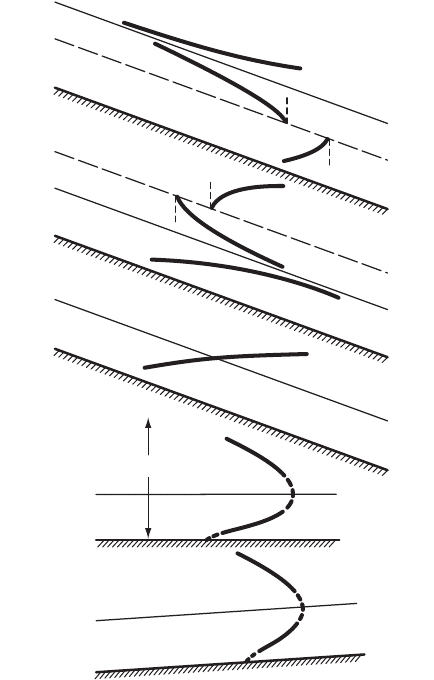
Open Channel Hydraulics 30-17
inflection point is slightly larger than S
o
, which means that the profile has always a slope above the
horizontal line.
The Steep Slope Profiles (y
o
< y
c
)
The S
1
Profile (y
c
< y)
In this case > 0, and > 0, so dy/dx is always positive; and y grows as x increases from a starting
datum. If this datum coincides with the critical depth y
c
, then the profile grows from it with infinite
slope. The slope decreases very rapidly to become S
o
for large values of x (where the values of y are large).
This means that the S
1
profile has a horizontal asymptote for x Æ •. Since S
1
is a subcritical profile, it
is drawn from downstream to upstream, always below a horizontal line through the known control point
P
1
. It cuts the y
c
line vertically at Q.
The S
2
Profile (y
o
< y < y
c
)
Since in this case > 0 and < 0, dy/dx is always negative; and y decreases as x increases from the
starting datum. If this datum coincides with the critical depth y
c
, then the profile decreases from an initial
infinite slope to approach y
o
asymptotically. Since S
2
is a supercritical profile, it is drawn from upstream
to downstream through a control point such as P
2
.
FIGURE 30.9 Gradually varied flow water surface curves.
M
1
M
2
M
3
y
0
y
0
y
0
=y
c
y
0
=
∞
y
c
y
c
y
c
y
c
P
6
P
7
P
1
P
2
P
3
P
5
P
4
S
1
S
2
S
3
C
3
H
3
H
2
A
2
A
3
C
1
Q
S
0
<S
c
S
0
>S
c
S
0
=S
c
S
0
=0
S
0
<0
© 2003 by CRC Press LLC
